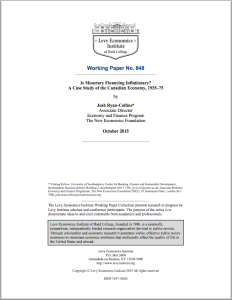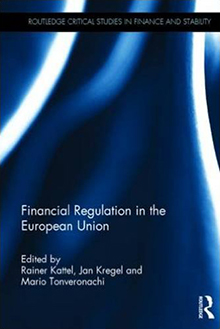L. Randall Wray | November 20, 2015
Yesterday, Senator Bernie Sanders gave an important speech in which he invoked President Roosevelt’s “Second Bill of Rights” in defense of his platform. As Bernie rightly pointed out, all of Roosevelt’s New Deal social programs to which we have become accustomed were tagged as “socialism”—just as pundits are branding Bernie’s proposals as dangerous socialist ideas. You can see Bernie’s prepared remarks here.
Just before Bernie’s speech, I was asked to do an interview with Alex Jensen, on TBS eFM’s “This Morning” English radio program in Seoul, Korea. I was sent a list of questions and jotted down very brief responses. Unfortunately, in our radio interview we were only able to get through a few of these. You can listen to the interview here (“1119 Issue Today with Professor L.R. Wray”).
As you will see, in addition to the subject of MMT and its critics, we talked about the platform of Senator Sanders and why his proposals have caught the imagination of the US population.
Here are some of the questions and my brief (written) answers. continue reading…
Comments
Michael Stephens | November 13, 2015
by Josh Ryan-Collins
The theoretical and policy arguments for monetary reform are becoming more accepted by economists and establishment figures. The financial crisis blew apart the idea that deregulated private money creation by commercial banks leads to more efficient outcomes and allocation of capital, as has been noted by Martin Wolf of the Financial Times and Lord Adair Turner, amongst others. Yet there are few examples of how public money creation – and its variants – can support economic growth without causing negative side effects, not least inflation.
 In a new working paper, I examine the case of the Bank of Canada (the Canadian central bank) in the 1935-1975 period, perhaps the most interesting example of public money creation in the 20th century in the English speaking world. Throughout this period the Bank of Canada engaged in significant direct or indirect monetary financing of government debt. In other words, the central bank created new money that was credited to the government’s account either via purchase of government bonds or direct lending. On average, about one-fifth of government debt was financed and held by the central bank, with all interest returning to the state (Figure 1).
In a new working paper, I examine the case of the Bank of Canada (the Canadian central bank) in the 1935-1975 period, perhaps the most interesting example of public money creation in the 20th century in the English speaking world. Throughout this period the Bank of Canada engaged in significant direct or indirect monetary financing of government debt. In other words, the central bank created new money that was credited to the government’s account either via purchase of government bonds or direct lending. On average, about one-fifth of government debt was financed and held by the central bank, with all interest returning to the state (Figure 1).
Figure 1: Monetary financing and consumer price inflation in Canada, 1935-2012[1]

This monetary financing supported the Canadian state to recover from the Great Depression, fight World War II, enable post-war reconstruction and, in the 30 years following the war, enjoy the longest period of economic growth and high employment in its history. The Bank also created one of the worlds’ largest industrial development banks for the financing of small and medium sized enterprises (SMEs), eventually providing a quarter of all loans to SMEs, again funded via public money creation.
It is a remarkable story and one few economists or economic historians have examined. Even more remarkable is the fact that this vast monetisation program did not prove to be inflationary. continue reading…
Comments
Michael Stephens | November 11, 2015
A new volume on EU financial regulation edited by Rainer Kattel, Jan Kregel, and Mario Tonveronachi:

Have past and more recent regulatory changes contributed to increased financial stability in the European Union (EU), or have they improved the efficiency of individual banks and national financial systems within the EU? Edited by Rainer Kattel, Tallinn University of Technology, Director of Research Jan Kregel, and Mario Tonveronachi, University of Siena, this volume offers a comparative overview of how financial regulations have evolved in various European countries since the introduction of the single European market in 1986. The collection includes a number of country studies (France, Germany, Italy, Spain, Estonia, Hungary, Slovenia) that analyze the domestic financial regulatory structure at the beginning of the period, how the EU directives have been introduced into domestic legislation, and their impact on the financial structure of the economy. Other contributions examine regulatory changes in the UK and Nordic countries, and in postcrisis America.
You can read an excerpt (which includes the Introduction and part of Chapter 2) at Routledge.
Table of contents below the fold: continue reading…
Comments
Michael Stephens | November 10, 2015
The 2016 Minsky conference will be held here at Blithewood mansion, home of the Levy Institute. Barney Frank will be among the keynote speakers:
Will the Global Economic Environment Constrain US Growth and Employment?
Organized by the Levy Economics Institute of Bard College with support from the Ford Foundation
Levy Economics Institute of Bard College
Blithewood
Annandale-on-Hudson, New York 12504
April 12–13, 2016
The 2016 Minsky Conference will address whether what appears to be a global economic slowdown will jeopardize the implementation and efficiency of Dodd-Frank regulatory reforms, the transition of monetary policy away from zero interest rates, and the “new” normal of fiscal policy, as well as the use of fiscal policies aimed at achieving sustainable growth and full employment.
Participants
continue reading…
Comments
Michael Stephens | November 4, 2015
“Hyman Minsky is the most important economist since Keynes, yet it’s virtually impossible to find any books about him.”
That’s from Michael Pettis’s blurb for Randy Wray’s new book Why Minsky Matters, which is now shipping:

Hyman Minsky’s name has appeared in the popular press a lot more since the financial crisis, but often without much more elaboration of his ideas than a paragraph noting (to the bewilderment of non-economists) that his economic research stands out because of the way in which it takes into account the significance of the financial sector and the possibility of financial crises.
And as Wray points out, reading Minsky can be a challenge (though one you won’t regret embracing: you can browse through the digital archive of his papers here). This book is a guided tour of Minsky’s work, covering everything from his views on the inherent instability of the financial dynamics of capitalism to his work on poverty and full employment policies.
The book’s introduction is available for download (pdf), and Arnold Kling (who declares himself “not completely converted”) just posted a nice review.
Comments







 ShareThis
ShareThis